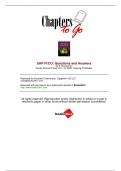Exam (elaborations)
SAP FI/CO: Questions and Answers
- Course
- Institution
Financial Accounting (FI) General 75. Explain ‘Financial Accounting (FI)’ in SAP. The ‘FI (Financial Accounting)’ module of SAP is the back-bone, which records, collects, and processes financial transactions or information on a real-time basis to provide the necessary inputs for e...
[Show more]



